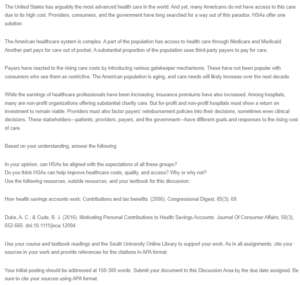Health Savings Accounts
HSAs alignment to group expectations
There is little doubt that health savings accounts may be arranged to suit all patients, providers, participants, and government needs. Considering that most people find it challenging to make a one-time contribution, health savings accounts could be the answer. Non-profit organizations can be rewarded with returns associated with treatment expenditures to maintain viability. Making the resources of government and non-profit organizations available to a particular group of individuals based on their financial and social circumstances can aid in the short-term management of the issue (Dion et al., 2021). With a defined strategic leadership, deploying health savings accounts can help make these services available to many people.
Impact of HSAs on the cost, quality, and access to healthcare
Utilizing tried-and-true financial advantages that encourage consumers and suppliers to increase price and expense, health savings accounts, and elevated health plans promote pricing transparency and may reduce cost. One may reduce their healthcare expenses by using tax-free funds from a health savings account to reimburse for premiums, copayments, insurance, and other fees. Due to their triple tax benefits, HSAs are advantageous as both an investment and savings vehicle (Dion et al., 2021). Withdrawals for acceptable medical costs are tax-free. Every donation made to an HSA is tax-free.
Additionally, any investment expense and interest income from savings are tax-free. Tax-free withdrawals assist in paying for medical expenditures. Furthermore, anybody, including the owner’s family and employer, can donate money. The ability to carry over unused funds from one year to the next enables people to begin amassing a savings account, improving healthcare access for most individuals. A rising body of research suggests that HSAs could finally provide some relief for aggressive Americans (Sommers et al., 2018). HSAs may not always promote access to healthcare, and their benefits to consumers are not necessarily universal. The accounts might not be the best option to pay for services because they are not perfect for all customers.
References
Dion, K. W., Oerther, D. B., & White, K. M. (2021). Mastering the Health Savings Account. Nursing Economics, 39(5), 255-259.
Sommers, B. D., Fry, C. E., Blendon, R. J., & Epstein, A. M. (2018). New approaches in Medicaid: work requirements, health savings accounts, and health care access. Health Affairs, 37(7), 1099-1108. https://doi.org/10.1377/hlthaff.2018.0331
ORDER A PLAGIARISM-FREE PAPER HERE
We’ll write everything from scratch
Question
The United States has arguably the most advanced health care in the world. And yet, many Americans do not have access to this care due to its high cost. Providers, consumers, and the government have long searched for a way out of this paradox. HSAs offer one solution.

Health Savings Accounts
The American healthcare system is complex. A part of the population has access to health care through Medicare and Medicaid. Another part pays for care out of pocket. A substantial proportion of the population uses third-party payers to pay for care.
Payers have reacted to the rising care costs by introducing various gatekeeper mechanisms. These have not been popular with consumers who see them as restrictive. The American population is aging, and care needs will likely increase over the next decade.
While the earnings of healthcare professionals have been increasing, insurance premiums have also increased. Among hospitals, many are non-profit organizations offering substantial charity care. But for-profit and non-profit hospitals must show a return on investment to remain viable. Providers must also factor payers’ reimbursement policies into their decisions, sometimes even clinical decisions. These stakeholders—patients, providers, payers, and the government—have different goals and responses to the rising cost of care.
Based on your understanding, answer the following:
In your opinion, can HSAs be aligned with the expectations of all these groups?
Do you think HSAs can help improve healthcare costs, quality, and access? Why or why not?
Use the following resources, outside resources, and your textbook for this discussion:
How health savings accounts work: Contributions and tax benefits. (2006). Congressional Digest, 85(3), 69.
Duke, A. C., & Cude, B. J. (2016). Motivating Personal Contributions to Health Savings Accounts. Journal Of Consumer Affairs, 50(3), 652-665. doi:10.1111/joca.12094
Use your course and textbook readings and the South University Online Library to support your work. As in all assignments, cite your sources in your work and provide references for the citations in APA format.
Your initial posting should be addressed at 150-300 words. Submit your document to this Discussion Area by the due date assigned. Be sure to cite your sources using APA format.

